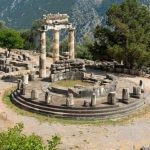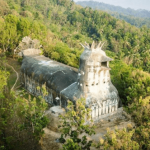 Music
Music  Music
Music  History
History 10 Less Than Jolly Events That Occurred on December 25
 Weird Stuff
Weird Stuff 10 Funny Ways That Researchers Overthink Christmas
 Politics
Politics 10 Political Scandals That Sent Crowds Into the Streets
 Weird Stuff
Weird Stuff Ten Bizarre Facts About The Doge Meme
 Our World
Our World 10 Ways Your Christmas Tree Is More Lit Than You Think
 Movies and TV
Movies and TV The 10 Coolest Stars to Set Sail on The Love Boat
 History
History 10 Things You Didn’t Know About the American National Anthem
 Technology
Technology Top 10 Everyday Tech Buzzwords That Hide a Darker Past
 Humans
Humans 10 Everyday Human Behaviors That Are Actually Survival Instincts
 Music
Music 10 Surprising Origin Stories of Your Favorite Holiday Songs
 History
History 10 Less Than Jolly Events That Occurred on December 25
 Weird Stuff
Weird Stuff 10 Funny Ways That Researchers Overthink Christmas
Who's Behind Listverse?

Jamie Frater
Head Editor
Jamie founded Listverse due to an insatiable desire to share fascinating, obscure, and bizarre facts. He has been a guest speaker on numerous national radio and television stations and is a five time published author.
More About Us Politics
Politics 10 Political Scandals That Sent Crowds Into the Streets
 Weird Stuff
Weird Stuff Ten Bizarre Facts About The Doge Meme
 Our World
Our World 10 Ways Your Christmas Tree Is More Lit Than You Think
 Movies and TV
Movies and TV The 10 Coolest Stars to Set Sail on The Love Boat
 History
History 10 Things You Didn’t Know About the American National Anthem
 Technology
Technology Top 10 Everyday Tech Buzzwords That Hide a Darker Past
 Humans
Humans 10 Everyday Human Behaviors That Are Actually Survival Instincts
Top 10 Religious Architectural Marvels
Explore the spiritual wonders that surpass time and culture. From ancient temples to towering cathedrals, this list captures the devotion of civilizations worldwide, offering insight into the connection between faith and architecture. Here are the top ten religious architectural marvels.
Related: 10 Amazing Ancient Buildings Still In Use Today
10 Temple of Hatshepsut, Egypt
Within the cliffs of Egypt’s Valley of the Kings stands a timeless wonder: the Temple of Hatshepsut. This ancient marvel pays tribute to one of Egypt’s most fascinating pharaohs, Queen Hatshepsut, who ruled around 3,500 years ago.
This temple’s unique design blends seamlessly with the surrounding natural landscape. Carved into the towering limestone cliffs, the temple’s terraced architecture seems like an extension of the rocky terrain, earning it the nickname “Djeser-Djeseru,” meaning “Holy of Holies.”
Dedicated to the sun god Amun-Ra, the Temple of Hatshepsut served as a place of worship and a mortuary temple for the queen. Its grandness reflects the power and wealth of the New Kingdom era, showcasing intricate reliefs, colossal statues, and imposing colonnades.
One of the temple’s most striking features is its three-tiered structure, each level adorned with elaborate colonnades and chapels. The temple’s central axis aligns with the winter solstice sunrise, emphasizing its connection to celestial symbolism and the afterlife.
Despite centuries of erosion and plunder, the Temple of Hatshepsut remains a testament to ancient Egyptian invention and craftsmanship. Its legacy continues to captivate visitors worldwide, offering a glimpse into the wonders of Egypt’s golden age and Queen Hatshepsut’s reign.
9 La Sagrada Familia, Spain
La Sagrada Familia in Barcelona, Spain, is the brainchild of architect Antoni Gaudí and encompasses the enduring spirit of the Catholic faith. This jaw-dropping basilica is a work of art and has been under construction for over a century. Yep, you read that right—it’s been in the making since 1882.
Gaudí poured his heart and soul into La Sagrada Familia, infusing it with his unique architectural style, blending Gothic and Art Nouveau elements. The result? An interesting fusion of facades, spires, and stained glass bathing the interior in color.
Despite its fame, La Sagrada Familia is still a work in progress. Gaudí famously said, “My client is not in a hurry,” referring to God. So it’s no surprise that construction is ongoing today, funded by donations and ticket sales from millions of visitors who admire its beauty.
As the largest Roman Catholic church in the world, La Sagrada Familia is dedicated to the Holy Family—hence the name—which holds profound meaning for Catholics worldwide.
8 Hagia Sophia, Turkey
Hagia Sophia in Turkey is the OG of architectural masterpieces, and it’s not just because it’s been around for over 1,500 years. This place has seen it all—from being a church to a mosque to a museum. Talk about a cultural chameleon.
This marvel is situated in Istanbul and is a testament to Byzantine and Ottoman architectural genius. Originally built in AD 537 by the Byzantine Emperor Justinian I, it served as an Eastern Orthodox cathedral for over 900 years.
When the Ottomans conquered Constantinople (now Istanbul) in 1453, Hagia Sophia underwent a makeover, transforming into a mosque. Minarets (tall, skinny towers) were added, and the interior received a stunning makeover with Islamic calligraphy and mosaics.
Fast-forward to 1935, when Turkey’s first president, Mustafa Kemal Atatürk, turned Hagia Sophia into a museum. Today, the site is once again a mosque and a UNESCO World Heritage Site. Hagia Sophis represents a fusion of Christian and Islamic heritage, symbolizing religious tolerance and cultural exchange.
7 Florence Cathedral, Italy
Towering over the cityscape of Florence like a majestic giant, the Florence Cathedral, also known as the Cathedral of Santa Maria del Fiore, is a blend of art, history, and faith. This architectural wonder embodies the creativity of the Renaissance era.
Completed in 1436 after 140 years of construction, this cathedral is a masterpiece of Gothic architecture. Its iconic red-tiled dome, designed by Filippo Brunelleschi, is the largest brick dome ever constructed. At a jaw-dropping 376 feet (114.6 meters) tall, you can’t help but be awestruck by its sheer magnitude.
Stepping inside the cathedral, you’re surrounded by grandeur. The interior is decorated with frescoes and stained glass windows, showcasing the skill of the Renaissance artisans. The cathedral also houses priceless works of art, including Michelangelo’s famous sculpture, La Pietà, and Giotto’s exquisite bell tower.
But beyond its architecture, the Florence Cathedral holds deep religious significance for Catholics. It serves as the mother church of the Roman Catholic Archdiocese of Florence and is dedicated to the Virgin Mary. The cathedral’s striking façade, trimmed with sculptures and marble panels, tells biblical stories and symbolizes the journey of faith.
6 Lotus Temple, India
Tucked in New Delhi, India, amidst a sea of noise and chaos, lies a serene oasis, the Lotus Temple. This architectural gem is a symbol of unity and peace. Shaped like a blooming lotus flower, the temple hosts the Bahá’í Faith, a religion that preaches the oneness of humanity.
Once visitors step inside, they are greeted with a sense of tranquility. The temple’s design is striking and functional, with 27 white marble “petals” arranged in perfect symmetry surrounding a central prayer hall capable of holding up to 2,500 worshippers.
Aside from its aesthetic appeal, the Lotus Temple stands out for its inclusive nature. Regardless of faith or background, all are welcome to enter and meditate. It’s where people from all walks of life come together to seek solace and spiritual renewal.
Constructed in 1986, the Lotus Temple has since become one of the most visited religious sites in the world, attracting millions of tourists and pilgrims each year. Its significance extends beyond its architectural beauty and serves as a beacon of hope and tolerance in a world often divided by religious and cultural differences.
5 Angkor Wat, Cambodia
Angkor Wat in Cambodia is a majestic witness of the ingenuity and devotion of ancient Khmer civilization. Amid the jungles near Siem Reap, this architectural marvel is a sprawling complex spanning over 400 acres, making it the largest religious monument in the world.
Built in the early 12th century by King Suryavarman II, Angkor Wat was initially dedicated to the Hindu god Vishnu but later transformed into a Buddhist temple complex. Its design fuses intricate Khmer architecture and symbolism, with its five towers representing Mount Meru, the mythical home of the gods in Hindu and Buddhist cosmology.
Visitors are transported back in time as they walk through detailed bas-relief corridors, witnessing scenes from Hindu epics like the Ramayana and Mahabharata. Each carving tells a story, depicting battles, religious rituals, and celestial beings in incredible detail.
One of the most captivating features of Angkor Wat is its alignment with celestial bodies. During the spring equinox, the sun rises directly behind the central tower, creating a breathtaking silhouette against the dawn sky—a phenomenon that draws pilgrims and tourists alike.
4 St. Basil’s Cathedral, Russia
St. Basil’s Cathedral in Moscow, Russia, displays Russian architecture and religious passion. Tucked within the iconic Red Square, this masterpiece of domes and swirling colors symbolizes Russia’s rich cultural heritage and deep spiritual roots.
Built in the 16th century under the reign of Ivan the Terrible, St. Basil’s Cathedral commemorates the conquest of Kazan and Astrakhan. Legend has it that Ivan was so amazed by the cathedral’s beauty that he ordered the architect, Postnik Yakovlev, to be blinded to prevent him from ever creating anything as magnificent again. Whether true or not, it speaks to the cathedral’s appeal.
What sets St. Basil’s apart is its unique architectural style, characterized by its colorful onion domes and intricate patterns. Each dome represents a different chapel. The overall effect is a kaleidoscope of shapes and hues. Inside, the cathedral hosts stunning frescoes and iconostases, transporting visitors to another world of religious devotion and artistic mastery.
Despite its name, St. Basil’s Cathedral is dedicated to the Protection of the Virgin Mary, a feast day celebrated in the Russian Orthodox Church. It served as the official chapel of the Russian tsars until the 18th century and has since become one of Moscow’s most beloved landmarks.
Today, St. Basil’s Cathedral attracts visitors from around the globe, drawn not only by its architectural wonder but also by the spiritual energy that permeates its walls. It’s a place where history and faith converge, leaving an impression on all who see it.
3 Shaolin Monastery, China
The Shaolin Monastery is one of China’s most famous religious architectural marvels. Located in the Henan province, it is a Buddhist temple that has existed for over 1,500 years. The monastery is not only a place of worship but also a center for martial arts training. It is considered the birthplace of Kung Fu.
The Shaolin Monastery was founded in the 5th century by the Indian monk Bodhidharma. Built in the foothills of the Songshan Mountain range, the temple complex has many buildings, including the main hall, pagodas, and courtyards. The architecture of the Shaolin Monastery is a mix of Indian and Chinese styles.
The Shaolin Monastery is an important site for followers of the Chan sect of Buddhism. The monks at the temple follow a strict regimen of meditation, prayer, and physical training. They are well-known for their mastery of martial arts and have been depicted in many movies and TV shows.
The monastery has a rich history and has survived many challenges over the centuries. During the Tang Dynasty, it was a center of learning and attracted many scholars. In the 20th century, it was damaged during the Cultural Revolution, but it has since been restored and is now a UNESCO World Heritage Site.
2 Al-Aqsa Mosque, Jerusalem
In the heart of the Old City of Jerusalem, the Al-Aqsa Mosque is one of the most revered sites in Islam and a striking example of architectural prowess.
Dating back over a thousand years, Al-Aqsa holds a special place in Islamic history. According to Islamic tradition, it’s the third holiest site after Mecca and Medina. Muslims believe that Prophet Muhammad journeyed to this sacred spot during the Night Journey, making it a go-to pilgrimage destination.
The mosque itself is a marvel of architectural ingenuity. Its sprawling complex covers approximately 35 acres and includes the mosque, gardens, courtyards, and other structures. The iconic silver dome, supported by elegant arches and pillars, dominates the skyline of Jerusalem’s Old City.
Throughout its long history, Al-Aqsa has witnessed the rise and fall of empires, survived numerous conflicts, and stood as a beacon of resilience and devotion. Its significance extends beyond religious boundaries, attracting visitors from all walks of life who admire its beauty and soak in its spiritual aura.
1 Wat Rong Khun, Thailand
Wat Rong Khun, commonly known as the White Temple, is an exquisite religious structure in Chiang Rai, Thailand. Although it is a relatively new temple, its unique design has made it one of Thailand’s most popular tourist destinations.
The artist Chalermchai Kositpipat designed the temple, which opened its doors to the public in 1997. Although it is a Buddhist temple, its design is unlike any other in Thailand. The entire structure is painted white to symbolize the purity of Buddha, and it is covered in tiny mirrors, which make it sparkle in the sunlight.
One of the temple’s most striking features is the bridge leading to the main entrance. The bridge is known as the “Bridge of the Cycle of Rebirth,” and it represents the journey from the cycle of rebirth to the state of enlightenment.
Visitors can see detailed murals inside the temple depicting the struggle between good and evil. The murals are painted in a contemporary style and include images of Superman, Batman, and other pop culture icons. The message behind the murals is that even in modern times, we still face the struggle between good and evil.








